Controllable Kites in Kiteboarding: A Detailed Overview

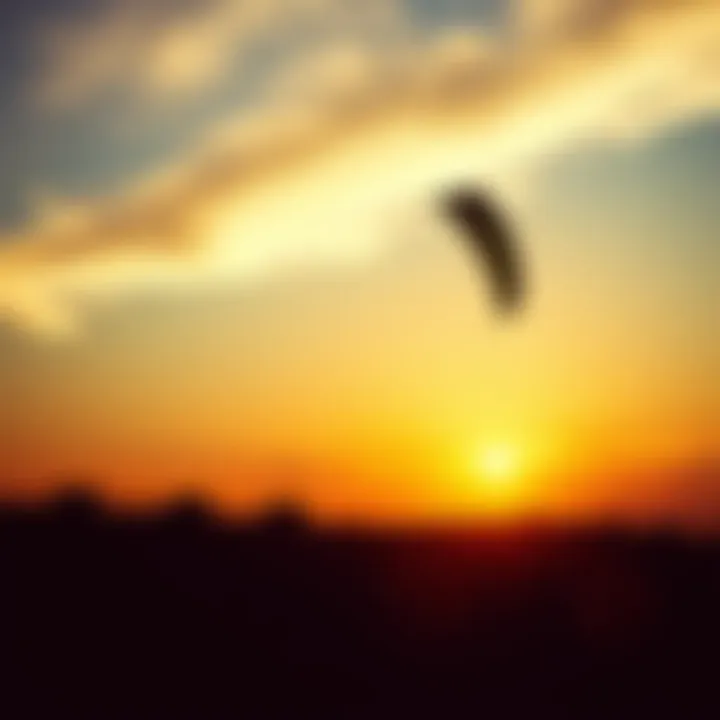
Intro
Kiteboarding, a thrilling blend of surfing and flying, has captivated enthusiasts for decades. Among its tools of the trade, controllable kites have emerged as pivotal in shaping the experience of both seasoned riders and newcomers alike. The rise of these kites, which offer an unprecedented level of control and adaptability, opens up a wider scope for maneuvers and challenges, making the sport not just about balancing on water, but about mastering the skies.
In this exploration, we will dive deep into the nuanced world of controllable kites. The aim is to unearth the complexities behind their technical specifications, examine modern design innovations, and layout their performance capabilities. Beyond just technical prowess, we emphasize the practical aspects: optimal usage, maintenance, and the vital safety measures necessary for enjoying the sport responsibly.
The discussion is tailored for kiteboarders of all skill levels. Whether you're just starting out or are a seasoned veteran seeking to refine your technique, there will be something useful for you. We will also touch on environmental impacts associated with kiteboarding, fostering a responsible approach to this exhilarating sport.
Let’s get started on this journey into the heart of kiteboarding and discover how controllable kites have not just transformed the sport, but also enhanced the experience of those brave enough to ride the wind.
Preamble to Controllable Kites
The realm of kiteboarding is as much about skill and excitement as it is about understanding the tools that elevate the experience—namely, controllable kites. These kites offer both novice and seasoned riders the ability to manipulate their movements and the feel of their ride through fine control and responsive design. This article section sheds light on why controllable kites are integral to the sport and how they both enhance performance and enrich users' ability to engage with wind and water.
Definition and Purpose
Controllable kites specifically refer to a category of kites that can be maneuvered reliably with more precision than traditional kites. By allowing users to dictate their position in the air, controllable kites facilitate more dynamic riding experiences.
Their main purpose is to grant riders enhanced steering and responsiveness, greatly impacting performance in diverse wind conditions. Riders can navigate more effectively, execute tricks, or maintain balance against gusts that might easily disrupt a less controllable kite. Beyond just performance, these kites serve to enrich the sport’s overall experience, making it accessible to a broader demographic, from first-time kiteboarders to advanced competitors.
Historical Evolution
The journey of controllable kites traces back to early kiting experiments around the globe. Initially, kites were basic tools used for leisure or even scientific purposes, primarily lacking the controllability that kiteboarders now enjoy. As the sport of kiteboarding exploded in popularity in the late 20th century, so too did advancements in kite designs.
The early designs in the 1970s and 80s reflected rudimentary forms of control that depended heavily on the skill of the rider rather than the inherent design of the kite itself. This early iteration paved the way for notable advancements seen in the 1990s with the arrival of inflatable kites.
Inflatable designs revolutionized the kiteboarding world by offering increased stability and buoyancy, allowing for better control in various wind and water conditions. Over the years, developments such as double-skin foil designs and bridled kites emerged, all contributing to improved performance and ease of handling.
Today, we have advanced control systems that include features such as power steering and varying aspect ratios, enhancing the controllability and precision that riders expect. As designs continue to evolve, the understanding of dynamics within controllable kites becomes ever more refined.
As kiteboarding progress, it is clear that controllable kites have played a pivotal role, shaping both the competition scene and recreational use. These kites foster not only individual growth in skills but also a collective evolution of the sport.
"A kite isn't just a piece of fabric. It's a gateway to the wind and water, allowing the rider to connect with nature more profoundly than ever before."
Types of Controllable Kites
Understanding the various types of controllable kites is crucial to mastering the art of kiteboarding. Each type serves a specific purpose and is tailored to meet certain conditions, making the selection of the right kite an essential aspect of the sport. The right kite can dramatically affect performance and enjoyment, especially for those at different skill levels. This section explores three prominent kite types: foil kites, leisure kites, and competition kites.
Foil Kites
Foil kites are a popular choice among kiteboarders due to their advanced design and versatile nature. They consist of multiple cells that inflate with air, forming a wing-like structure that can efficiently harness wind power. This design allows for effective control and stability, even in varied wind conditions.
Benefits of Foil Kites:
- Efficiency in Light Winds: Foil kites can generate significant lift even when wind speeds are low, making them ideal for onshore or light wind conditions.
- Compact Storage: When deflated, these kites are easy to pack and carry, which is a boon for those who like to take their gear on travel trips.
- Durability: Many foil kites utilize robust materials, leading to longevity and resistance against wear and tear.
However, there are considerations. Foil kites require more finesse to control than other types, demanding a strong understanding of wind dynamics and rider technique. If a kiteboarder can navigate these complexities, a foil kite can enhance their kiteboarding experience significantly.
Leisure Kites
Leisure kites are exactly what they sound like: kites designed for casual outings and recreation. They come in many shapes and sizes, tailored more for enjoyment than competition or extreme performance. Often designed for ease of use, leisure kites are accessible to beginners.
Elements of Leisure Kites:
- User-Friendly Design: Most leisure kites come with straightforward setups and can be flown with minimal knowledge, making them perfect for families or those just dipping their toes into the kiteboarding world.
- Affordability: Typically, leisure kites are priced lower than specialized kites, making them a more budget-friendly option for first-timers.
- Versatile Use: Many leisure kites are suitable for different activities, whether it’s just flying or joining in on some light kiteboarding fun.
Despite their appealing features, leisure kites may lack the performance stability required for more serious kiteboarding. Riders should consider their goals before opting for a leisure kite, especially if they have ambitions beyond leisurely flying.
Competition Kites
In the competitive arena, performance is everything, and competition kites are engineered for this very purpose. These kites are built to maximize speed, control, and agility. Riders who enter competitions or challenges will find that utilizing a competition kite can provide that edge they need to stand out.
Characteristics of Competition Kites:
- Performance-Driven Design: Featuring advanced materials and design elements, these kites offer optimized performance, making them apt for challenging wind conditions.
- Precision Control: Riders experience heightened control with these kites, allowing for more intricate maneuvers and tricks.
- Investments in Innovation: Many manufacturers constantly upgrade their designs based on current competition trends and rider feedback, which often leads to state-of-the-art technology in the latest models.
However, competition kites can present a steeper learning curve. The intense responsiveness and specialized features may be overwhelming for novice riders. Typically, a solid foundation in basic kiteboarding skills is recommended before venturing into the realm of competition kites.
Ultimately, selecting the right type of controllable kite boils down to understanding one’s intentions and skills. Whether you go for a foil, leisure, or competition kite, aligning the choice with your level and aspirations will ensure a more fulfilling experience in kiteboarding.
Design Innovations in Controllable Kites
In kiteboarding, design innovations play a pivotal role in enhancing the experience of both the rider and the equipment. As technology advances, so too does the capability and performance of controllable kites, leading to exciting developments that not only improve usability but also safety and efficiency. Understanding these innovations can help enthusiasts make informed decisions while selecting their gear, ensuring they get the most out of their time on the water.
Material Advancements


Let’s start with material advancements. The materials used in kite construction have evolved significantly over the years, leading to kites that are stronger yet lighter. Traditional fabrics have been replaced with advanced composites, such as ripstop nylon and mylar, which resist tearing and provide durability without adding weight. This transition allows for a more enjoyable ride as riders can achieve higher speeds and better maneuvers while expressing confidence that their kite can withstand the elements.
"Kiteboarding isn't just a sport; it's about pushing boundaries, and the right materials make that possible."
- Lightweight fabrics: These reduce drag, allowing the kite to respond swiftly and efficiently to rider inputs.
- UV-resistant coatings: They protect against sun damage, prolonging the lifespan of the kite.
- Reinforced stitching: Enhanced stitching technologies ensure that seams do not fail during high-stress maneuvers, an essential consideration for serious riders.
If you're investing in a new controllable kite, these material innovations should be high on your checklist. They not only improve performance but can also save you from needing frequent replacements, which ultimately offsets costs in the long run.
Aerodynamics and Performance
Next on the list is aerodynamics and performance. The evolution of design has introduced shapes and profiles that optimize airflow, resulting in kites that generate more lift and faster speeds.
- Leading-edge design: This is crucial as it dictates how the kite cuts through the air. Modern kites often feature a more refined leading edge that enhances stability and allows for smooth transitions and turns.
- Wing shapes: Different designs like delta shapes or bow kites serve specific purposes. Bow kites, for instance, offer better low-end power, making them great for lighter wind conditions, while delta shapes work well in higher winds, providing versatility.
- Control surface: Innovations in control surfaces allow for better depower, giving riders more control over their speed and power, essential abilities for managing challenging conditions.
Riders who factor in these aerodynamic enhancements can expect enhanced performance and a smoother experience. As one learns to manipulate these aspects, the potential for what can be accomplished on the water grows exponentially.
Consider checking out resources discussing advanced kite designs on websites such as Wikipedia or forums like Reddit to get insights directly from the community and other users. Engaging with fellow kiteboarders can lead to discovering what innovations are trending and which have stood the test of time.
The importance of design innovations cannot be overstated in kiteboarding. They not only reflect the progression of technology but also cater to diverse riding styles, experiences, and conditions, ensuring that there truly is something on the market for every enthusiast.
The Mechanics of Control
Understanding the mechanics of control in kiteboarding is pivotal for both new and seasoned riders alike. This aspect profoundly influences how effectively a kite operates in various wind conditions. With the right control mechanisms, riders can maximize their performance and enjoyment, making it an essential focus in the world of controllable kites. The precision of control impacts everything from safety to the overall experience on the water.
Control Systems Explained
The heart of kiteboarding lies within its control systems. These systems can be broadly categorized into two types: bar and line systems and digital control mechanisms. Each of these systems plays a significant role in managing kite performance.
Bar and Line Systems
These traditional methods involve physical components that connect the rider to the kite. A typical setup includes:
- Control bar: This is the primary tool through which you steer the kite. Moving it left or right responds directly to your intended direction.
- Lines: Usually made from high-tensile materials, these lines connect the bar to the kite and are crucial for transmitting force and control.
Understanding how all these components interplay allows for finer control, especially in complex conditions. For instance, bar pressure indicates how much power the kite is generating, offering vital feedback to the rider. In the ever-changing environment of kiteboarding, being able to read these signals is key to maintaining control and stability.
Digital Control Mechanisms
Modern innovations have introduced a tech-savvy approach to kite control. Systems equipped with sensors that communicate data back to the rider’s device allow for real-time adjustments. This includes parameters like:
- Wind speed and direction
- Kite altitude
- Rider balance
Such systems provide a clear feedback loop, empowering experienced users to fine-tune their kiting experiences even further. Not only do these tools enhance safety, but they also situate kiteboarding at the intersection of technology and sport, attracting a new audience in the process.
"The beauty of kiteboarding lies in the control—understanding its mechanics opens up a world of potential."
User Techniques for Enhanced Control
To truly harness the mechanics of control, riders must master certain techniques. These skills make it possible to maneuver with precision and confidence, which leads to improved overall performance. Here are some essential user techniques that can elevate your kiteboarding game:
- Mastering Depower and Power: Understanding how to depower the kite reduces its pull during gusty winds. Using the depower strap allows a rider to adjust power levels on-the-fly, giving them a cushion of safety.
- Body Positioning: Central to kiteboarding control is the rider's body position. Keeping your body low to the board helps maintain balance, especially when navigating through turbulent waters.
- Edge Control: Effective edge control allows for smoother turns and jumps, making a big difference in tricks and overall enjoyment. Riders should practice shifting their weight and adjusting edges based on kite response.
- Feedback Utilization: Listening to your equipment is just as vital. For instance, if the kite starts to luff, it signals a need to regain tension. A keen sense of feedback, both auditory and physical, can guide your actions.
By employing these techniques, riders can significantly enhance their kite control. This not only fosters better skill acquisition but also ensures a safer, more enjoyable kiteboarding experience. Ultimately, mastering control mechanics equips kiteboarders with the tools they need to conquer diverse conditions and elevate their performance on the water.
Performance Considerations
When it comes to kiteboarding, the vibe of the wind can make or break your experience. Understanding performance considerations is key for every kiteboarder, regardless of whether you are a novice or an ace rider. The right kite can enhance your performance greatly and make your time on the water more enjoyable.
Wind Conditions and Kite Selection
Selecting the appropriate kite based on wind conditions is like picking the right tool for a job. You wouldn’t use a hammer to tighten a bolt, so why use a large kite in light wind?
Each kite is built for certain wind conditions, and this selection impacts your safety and skill development. Here’s what you need to consider:
- Light Winds (8-12 knots): Opt for larger kites, like a 12m or 14m. These kites catch more wind and provide the lift needed to get you moving. If you choose a smaller kite, you risk not having enough pull.
- Moderate Winds (12-20 knots): This is often the sweet spot for many kiteboarders. Kites in the range of 9m to 11m work best here. They are maneuverable enough for tricks but stable enough for cruising.
- Strong Winds (20+ knots): You’ll want to opt for smaller kites, perhaps around 7m to 9m. The power of the wind can be overwhelming, and utilizing a smaller kite means better control while still achieving speed.
"Choosing the right kite for the wind conditions isn't just about comfort; it's about keeping you safe on the water."
Understanding wind direction also matters. Crosswind conditions usually require different strategies than downwind or upwind scenarios. A kite that performs well in one direction may not hold up in another, so keep your options open and learn from local riders about what works best in specific locations.
Rider Skill Levels and Kite Compatibility
It’s not all about the kite itself; it’s also about the rider. Your skill level plays a significant role in selecting the most suitable kite. As a beginner, familiarity with kite sizes and types can speed up the learning process. Here are some thoughts to ponder:
- Beginners: A larger, more stable kite is recommended for those just starting. It allows for gradual learning and less chance of getting overpowered. Generally, 12m to 14m kites are favored to provide enough lift while giving you control.
- Intermediate: This is when you might explore different kite styles based on your personal style and preferences. A versatile kite that accommodates different tricks or wave riding can also boost your confidence.
- Advanced: As your skills progress, the type of kites you choose can vary widely dependent on whether you're focused on freestyle tricks, surfing, or speed. You may find hybrids or specialized competition kites to cater to your advanced maneuvers.
In the end, understanding your abilities and how they align with kite performance is essential. The wrong kite can hamper your learning curve or lead to risky situations. It’s all a balancing act, but with the right attention to detail, you can find the perfect fit that enhances your skills and enjoyment.
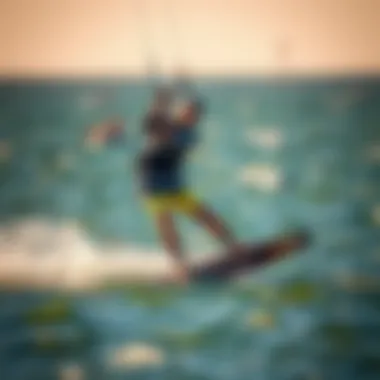
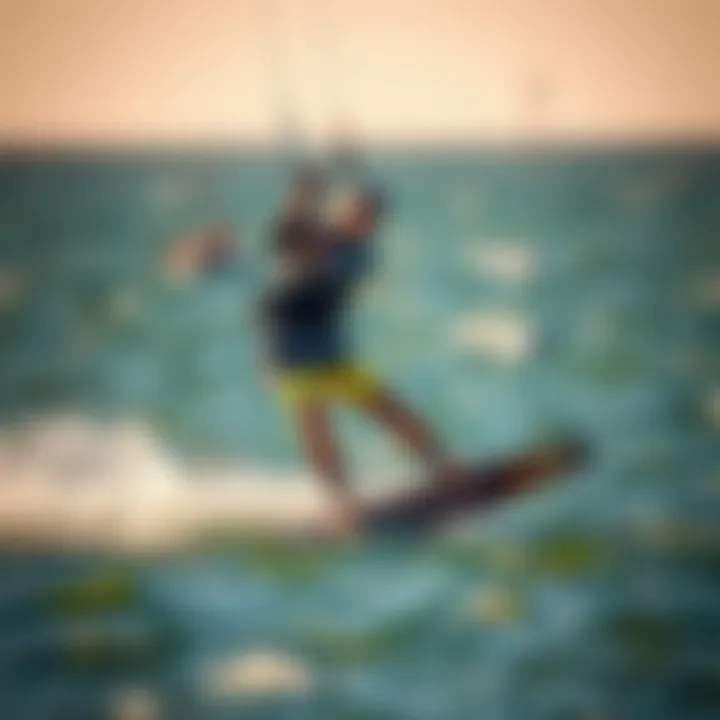
For more comprehensive discussions on the wind conditions and kite types, you can check Wikipedia and Britannica.
Ultimately, aligning wind conditions and personal skill levels with kite selection can elevate your kiteboarding experience to new heights.
Maintenance and Care for Controllable Kites
Taking care of controllable kites is just as crucial as mastering the wind and waves. Maintenance ensures kites remain in optimum condition, maximizing not just performance but also safety. Regular care can extend the lifespan of a kite, providing riders with that extra assurance when they are out there flying high. So, let's dive into the nitty-gritty of how to keep those kites in peak shape.
Inspection and Repairs
A good inspection routine can save a kite from premature retirement. After each session, take a moment to check for any signs of damage. Look closely at the seams, fabric, leading edge, and trailing edge of the kite. Pay attention to any small tears or frays. A tiny rip could compromise the kite's integrity during your next ride.
When it comes to repairs, having the right tools at hand can make a world of difference. Here are some effective steps to follow:
- Identify the Damage: Take the time to properly assess what needs fixing.
- Use Repair Tape: Specially designed kite repair tape works wonders for small cuts.
- Sew Larger Rips: If the damage is more extensive, some basic sewing skills are handy. A quick stitch can restore function.
- Professional Help: When in doubt, don’t hesitate to consult a professional. Specialized repair shops understand the specific needs for kite materials.
"Proper maintenance is not just about preventing breaks; it's about elevating your riding experience."
By sticking to a regular inspection routine and handling repairs promptly, kiteboarders can keep their kites performing flawlessly.
Storage Best Practices
Once the riding season wraps up, proper storage of controllable kites is paramount. Just like a well-tended garden needs care when winter comes, kites need respect when not in use. The wrong storage conditions can lead to mold growth, degradation of materials, and a whole heap of other issues. Here are some guidelines:
- Clean Before Storage: Washing the kite with fresh water and letting it dry will prevent salt and sand from causing wear and tear.
- Avoid Sunlight: Store kites in a cool, dark place; UV rays can weaken the fabric over time. A cloth bag or storage case is a smart investment.
- Fold, Don’t Roll: When it's time to put your kite away, fold it properly rather than rolling. It minimizes creases and preserves fabric integrity.
- Check Regularly: Even in storage, it’s a good idea to check the kite periodically for any unexpected wear or pest damage.
These storage practices ensure your kite stays in fine shape and ready for adventures when the wind calls.
Keep in mind, maintenance isn't just a chore; it's a vital step in enjoying kiteboarding to its full potential.
Environmental Considerations in Kiteboarding
The growing popularity of kiteboarding has raised important questions about its impact on the environment. As enthusiasts take to the skies and waters across the globe, understanding how these activities affect local ecosystems becomes crucial. This section delves into two significant aspects: sustainability practices that kiteboarders can adopt and the assessment of how different kiting locations impact the surrounding environment.
Sustainability Practices
When it comes to sustainability in kiteboarding, practices can significantly mitigate the sport's ecological footprint. Here’s a closer look at a few ways in which riders can embrace environmentally friendly habits:
- Eco-Friendly Gear: Opt for kites and equipment made from sustainable materials. Some brands have started producing kites from recycled plastics, ensuring that they are reducing waste while still maintaining high performance. This choice can also influence the market, prompting more manufacturers to consider the environmental impact of their products.
- Respecting Wildlife: Riders should inform themselves about local wildlife and habitats. For instance, avoiding areas during nesting seasons and steering clear of marine protected zones helps preserve delicate ecosystems. Awareness is key; ride in areas where the local fauna is least disturbed, ensuring that kiteboarding remains a harmonious activity with nature.
- Leave No Trace: This adage rings true for kiteboarding as well. Always pack out what you bring in. This includes gear packaging, food wrappers, and anything else that could end up in the water or on the beach. Participation in local clean-up efforts significantly enhances the community relationship with nature and reduces plastic pollution along waterways.
Impact Assessment of Kiting Locations
The choice of kiting locations has far-reaching environmental implications. Not all spots are created equal when it comes to sustainability:
- Assess Local Regulations: Before heading out, kiteboarders should familiarize themselves with local rules. Some areas may have restrictions to protect wildlife or reduce conflict with other water users. This not only promotes safety but also fosters a responsible community atmosphere. Keeping abreast of regulations can help prevent negative impacts.
- Evaluate Erosion and Habitat Changes: Over time, kiteboarding can lead to significant changes in landscapes, such as beach erosion. The constant foot traffic can compact sand and disrupt plant life that stabilizes the dune system. Engaging in community-led assessments can yield data which might help local authorities address these issues before they grow out of control.
"A little knowledge about one’s surroundings can go a long way in preserving them for future kiteboarders."
- Focus on Community Impact: How does kiteboarding affect local economies and communities? Promoting responsible tourism can uplift local businesses while minimizing interference with traditional livelihoods or local cultures. Supporting educational initiatives can also raise awareness among fellow riders about respecting nature.
By understanding both sustainability practices and assessing the impact of kiting locations, kiteboarders can play a crucial role in ensuring the sport remains sustainable and enjoyable for future generations. Thus, as interest in kiteboarding grows, so does the responsibility to preserve the fragile environments in which we ride.
For more insights into environmentally responsible practices in water sports, check out resources on eco-friendly kiting at www.surfrider.org and explore pollution awareness via www.epa.gov.
Safety Protocols in Kiteboarding
Kiteboarding is an exhilarating sport, but with great fun comes great responsibility, especially when it comes to safety. Safety protocols play a critical role in making sure that kiteboarders, whether beginners or experts, enjoy their experience without unnecessary risks. These protocols encompass everything from using the right equipment to knowing emergency procedures. Understanding and adhering to these measures can safeguard oneself and others in the kiteboarding environment.
Standard Safety Equipment
Every kiteboarder should equip themselves with a set of essential safety gear. The reality is, mishaps can happen, and being prepared can make a world of difference. Here are key pieces of standard safety equipment:
- Helmet: This isn’t just for show. A good helmet protects your noggin from unexpected falls or collisions, especially in crowded areas.
- Impact Vest: It absorbs shock and can safeguard your torso if you hit the water hard. Some vests also offer buoyancy, which is a plus.
- Harness: A well-fitted harness gives you the control you need while preventing undue strain on your body.
- Safety Leash: This is crucial. A safety leash detaches the kite from you in case of a malfunction, ensuring that you don’t end up tangled in a runaway kite.
- First Aid Kit: Always good to have on hand. It can be helpful after a tricky landing or a kite mishap.
- Flotation Device: For those venturing into deeper waters, it’s wise to wear something that keeps you afloat.
Investing in quality gear should never be compromised. Think of safety equipment as your best friend; you want it to be reliable in times of need.
Emergency Procedures
Even with the best preparation, something could go wrong. That’s where knowing your emergency procedures comes into play.
- Know Your Environment: Keep an eye on the weather. Sudden storms or changing wind patterns can catch you off guard. If you notice the wind is picking up too much, consider packing up and heading in.
- Quick Release: Make sure to practice using the quick release on your harness. In case of a crash or if the kite gets out of control, instant detachment is essential. This should be second nature for every kiteboarder.
- Communicate: If you’re out with others, make sure to keep open lines of communication. Hand signals work great if shouting is impractical due to the wind.
- Plan Your Exit: Before you hit the water, identify potential exit points. Should an emergency arise, knowing where and how you can efficiently exit can mean a quick, safe return to shore.
- Rescue Techniques: Familiarize yourself with self-rescue techniques. Being able to right yourself and your equipment after a fall can mitigate further hazards.
"Preparation and awareness are paramount. Knowing what to do in case of trouble can enhance your experience and keep everyone safe."
Implementing these protocols may seem tedious, but it is necessary for enjoying kiteboarding to the fullest. No one wants an unexpected swim that wasn’t part of the plan. Prioritizing safety means more fun on the water for everyone.
Choosing the Right Controllable Kite
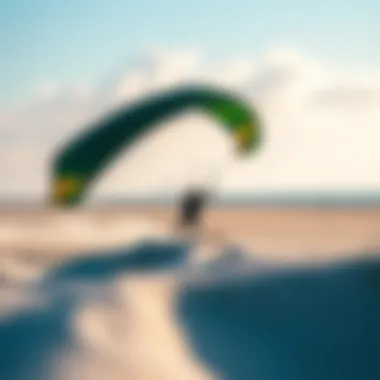
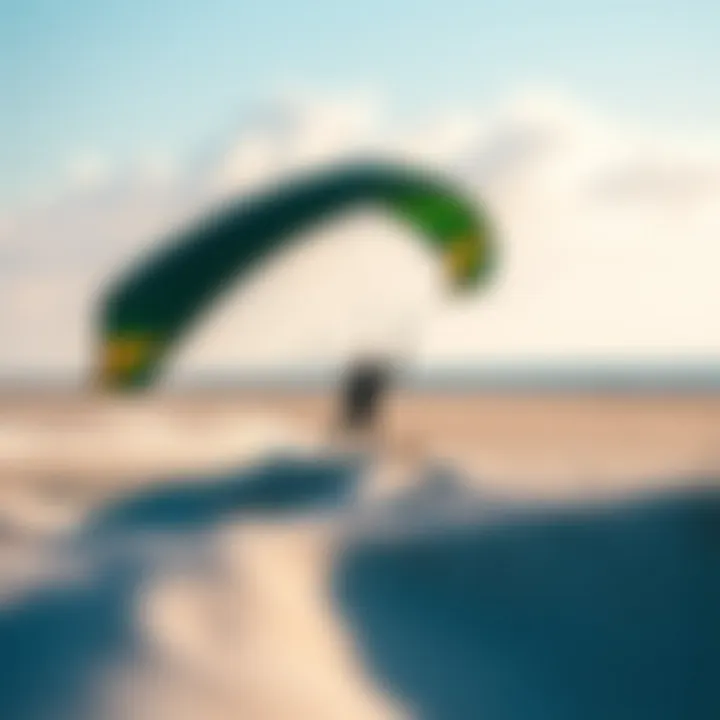
Selecting the right controllable kite is more than just picking a color you like or choosing the biggest one at the shop. It's fundamentally about aligning the kite's characteristics with your individual riding style, skill level, and the conditions you'll be encountering. A well-chosen kite can dramatically enhance your experience, making each outing on the water more enjoyable and safe.
This section dives deep into the key elements to consider when you're on the hunt for your perfect kite, helping you avoid common pitfalls and ensuring your choice brings out the best in your kiteboarding adventures.
Factors to Consider in Selection
When setting out to choose a controllable kite, there are several important factors that can tip the scales toward a successful purchase:
- Skill Level: If you’re just starting out, opting for a kite that is known for stability and ease of use can prevent a lot of unnecessary frustration. Beginners might benefit from choosing a larger kite that catches more wind without being overly aggressive.
- Wind Conditions: Understanding the typical wind speeds of your favorite spots plays a major role. A small kite might be suitable for high winds, but if your local beach is typically calmer, a larger kite could be a better fit.
- Kite Type: Different types of controllable kites are optimized for various conditions and riding styles. For instance, foil kites can shine in lighter winds but may require specific handling skills. In contrast, inflatables are known for their versatility and ease of use.
- Material Durability: Kites made from high-quality materials can withstand wear and tear better than others. This is a critical factor if you plan to kiteboard frequently or in harsh conditions. Look for kites with ripstop nylon or similar fabrics, as they offer added durability.
- Weight: A lighter kite can be easier to maneuver, especially in tricky conditions. However, weight is a double-edged sword; heavier kites may perform better in strong winds but can be cumbersome and exhausting during longer sessions.
Taking the time to evaluate these factors can help ensure that you make a decision that suits your personal adventures in kiteboarding.
Vendor and Model Reviews
Navigating through the vast array of kite options can be a bewildering experience, especially with varying reviews and opinions swirling around. A few trusted sources can be essential in cutting through the noise.
When considering models and brands, it's helpful to look at:
- User Feedback: Review platforms and forums such as Reddit can offer valuable insights into what real users think about specific kite models. Feedback from fellow kiteboarders can alert you to potential issues you might not see in a glossy ad.
- Brand Reputation: Some companies have built solid reputations through consistent product performance and customer service. Brands like North and Naish have long histories of quality and can often be a safe bet for reliable kites.
- Expert Recommendations: Professional instructors or local shops often have hands-on experience with various brands and models and can guide you toward trustworthy choices based on what works well in the surrounding conditions.
- Kite Reviews and Comparisons: Websites and blogs dedicated to kiteboarding often run thorough reviews comparing various models and their specific features, helping you see how kites stack up against each other.
The right kite vendor or model can make all the difference on the water. As the old saying goes, "You get what you pay for". So, invest your time in selecting the kite that suits your needs best.
Above all, remember that personal preference plays a key role in kiteboarding. Venture to demo different kites whenever possible, as the feel of the kite is something best experienced firsthand.*
"A kite might fly beautifully in theory, but it’s the practical test that reveals its true character."
Links for more insight:
Kiteboarding Destinations
Kiteboarding is much more than just a sport; it's an experience that thrives in the backdrop of breathtaking natural environments. Kiteboarding destinations are crucial to the overall enjoyment and practice of this exhilarating sport. The right location can significantly influence performance, skill development, and even the social aspects of kiteboarding. From open seas and breezy beaches to secluded lagoons and wave-rich coastlines, these destinations offer much more than just wind and water.
Choosing the proper kiteboarding location ensures you harness ideal wind conditions, enhancing the rider's experience. Each spot has its unique characteristics, such as wind patterns, water types, and local amenities—factors that make them particularly attractive to aspiring kiteboarders and seasoned pros alike.
Additionally, these locations provide opportunities for community interaction. Meeting fellow enthusiasts not only enriches the sport but also fosters camaraderie and knowledge-sharing among kiteboarders.
Top Locations for Kiteboarding
When considering kiteboarding destinations, several spots globally have gained popularity for their consistent wind and favorable conditions. Here is a list of some premier locations that kiteboarders often rave about:
- Cape Town, South Africa: Known for its strong winds, particularly during the summer months, Cape Town provides numerous beaches that cater to skill levels from beginner to pro.
- Hood River, Oregon, USA: The Columbia River Gorge creates a unique wind tunnel effect, making it a top choice for those wanting to ride in flatwater conditions.
- Tarifa, Spain: Dubbed the wind capital of Europe, Tarifa is blessed with favorable conditions year-round and a vibrant kiteboarding community.
- Mui Ne, Vietnam: With its pristine beaches and steady winds, Mui Ne attracts kiteboarders from all over the globe, offering a blend of culture and sport.
- Boracay, Philippines: This paradise is not only known for its white sandy beaches but also offers excellent kiteboarding conditions, especially between November and April.
Each of these locations boasts its distinct appeal, catering to varied tastes and preferences among kiteboarders.
Local Regulations and Etiquette
Understanding local regulations is essential for ensuring a safe and enjoyable kiteboarding experience. These rules vary from place to place, depending on factors like environmental protection, sports management, and community safety. It’s vital for kiteboarders to be aware of any restrictions regarding launch areas, equipment use, and interactions with other watercraft.
Moreover, kiteboarding etiquette cannot be overstated. Practicing courtesy ensures everyone enjoys the sport while minimizing risks of injury.
Key points to keep in mind include:
- Respecting Other Beachgoers: Maintain a safe distance from swimmers and non-kiteboarding watercraft.
- Using Designated Areas: Launch only from places permitted by local regulations, which often include signage.
- Understanding Right of Way: Familiarize yourself with navigation rules to avoid collisions, especially in crowded areas.
Adhering to local rules and etiquette not only enhances your experience but also helps in fostering a positive image of the kiteboarding community as a whole. It’s essential we show respect to the environment and fellow enthusiasts, ensuring kiteboarding remains a cherished activity for years to come.
"Kiteboarding is freedom, but with freedom comes responsibility—be mindful of the space around you."
By selecting the right locations and being conscientious about local regulations, kiteboarders can fully embrace this thrilling sport while respecting the natural beauty around them.
The Future of Controllable Kites
As we peer into the horizon of kiteboarding, the prospects for controllable kites are both exciting and promising. These technological marvels have already changed the face of the sport, but there's much more brewing in the wings. With advancements in materials, design, and propulsion systems, kiteboarders are poised to enter a new era of performance and safety that promises to enhance their experience. The focus now shifts to how various innovations will shape kiting, making it not just a sport but also a statement on environmental sustainability and user inclusion.
Technological Advancements on the Horizon
Emerging technologies are the lifeblood of any evolving sport, and kiteboarding is no exception. Several noteworthy advancements are on the cusp of reality that could redefine the user experience for kiteboarders.
- Smart Kites: Imagine kites that can monitor wind conditions or communicate with the rider's smartphone. These could provide live updates, allowing for real-time adjustments in techniques, enhancing safety and performance.
- Lightweight Materials: The next generation of controllable kites may utilize advanced composite materials, reducing weight and increasing durability. This change not only translates to improved maneuverability but also minimizes wear and tear.
- Enhanced Control Systems: Developments in remote control technology could lead to innovations where kites can stabilize themselves in varying wind conditions, allowing inexperienced riders to manage their balance more effectively.
The integration of such technologies will not only enhance the performance capabilities but also make the sport more accessible to individuals of all skill levels.
Predicted Trends in Kiteboarding
As the kiteboarding scene continues to evolve, several key trends are expected to emerge, shaping the way we think about controllable kites:
- Sustainability Focus: Kiteboarders are becoming increasingly aware of their environmental footprint. Expect to see manufacturers adopt eco-friendly materials and production processes, driving forward a green movement within the sport.
- Rise of Community Events: With the influx of new riders entering the sport, community events and gatherings are bound to expand. These events foster camaraderie and encourage skill-sharing among participants, strengthening the kiteboarding community.
- Customization Options: As personal preferences for kite setup increase, brands will likely offer more customization options. Riders want kites that reflect their individual styles and performance requirements.
- Inclusivity Initiatives: With a focus on expanding the reach of kiteboarding, companies and organizations may invest in programs aimed at making the sport accessible to underrepresented groups.
The future of controllable kites in kiteboarding is not just about performance; it’s about connecting with nature and fostering a sense of community among riders.
In summary, the future holds a kaleidoscope of possibilities for controllable kites, driven by technological advancements and changing societal values. As kiteboarding circles continue to grow and evolve, the innovations on the horizon could undoubtedly transform this thrilling sport into a powerful platform for advocacy, community engagement, and personal expression.















